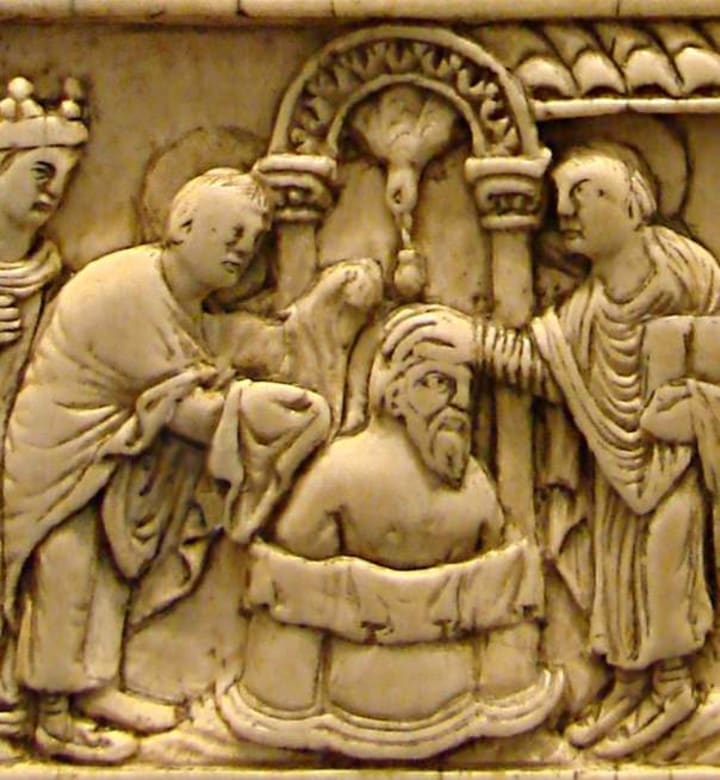Christianity in the Height and Fall of the Roman Empire
From small beginnings to overwhelming success

Christianity originated in Jerusalem as a sect of Judaism, forming into a separate religion and recognised as such by 64 CE (Green, 2010, 1). A significant proportion of the first Christians were indeed Jewish converts, although this is not to say that Christianity had a large number of followers in its beginnings. In truth, it was a measured process; breaking off from the larger religion of Judaism with the mission given to the Apostles to spread the values and beliefs of Christianity. The Apostles are not usually seen as being the first Christians, instead they are well known for their emphasised role in the spread of Christianity, particularly Paul after his own conversion. Paul and Peter's missions took them out of Jerusalem to preach this new religion and make conversions in Damascus and Syria at Antioch (Kee, 2005, 217). As the movement spread into the wider Graeco-Roman world, issues with paganism allowed the new religion to seem superior and a preference to many with what it offered. The Christians faced conflict with the Roman authority and suffered several major persecutions, but was never extinguished, however, and recognised new opportunities with the invasions of the barbarians to move further West into Germanic regions. I am exploring the journey Christianity took, what factors contributed to its advancement, and shows how the church "became the most profound historical influence on the world in which we now live" (Griffith, 1986, 432).
The Apostles
Followers of Jesus referred to themselves as 'Brethren', yet it was in Antioch, a city known for making up nicknames, that they were first called 'Christians' (Cheney, 1959, 67). Jesus' preaching was predominantly to the Jews of Galilee. During this time, the Roman Empire covered most of the known world and Jews were in all major cities, so "if any religion had a good chance of spreading through the world it would be one that began among the Jews" (Cheney, 1959, 67). This is exactly the case for Christianity, for within a few hundred years Christianity had developed from a mere sect of Judaism to being the focal point of the middle ages.
One of the first methods of increasing the Christian movement was when Jesus gave the Apostles the roles of "agents and spokesmen for the risen Christ" (Kee, 2005, 281) to preach the creed in Jerusalem. St Peter and St Paul in particular took this role beyond Jerusalem, hence leading to the outreach of Christianity into different regions including Cyprus, Syria, Antioch, Iconium and Lystra, and churches in Greece, Macedonia and Asia Minor (Kee, 2005, 281). Although there were controversies and mixed reactions, the news of the principles of Christianity and the resurrection of Jesus began to arise in regions of Europe. Thus, before Christianity developed structure and community, the Apostles were seen as "prime messengers and agents for the founding and spread of the new covenant community" (Kee, 2005, 400).
Of course it was not only preaching by the Apostles that persuaded people, but the conversion of the Gentiles (non-Jewish people), the miracle healings, and the aura of the Holy Spirit that supported their divine purpose (Kee, 2005, 286).
After the age of the Apostles, there was an apparent lack of charisma that was once prominent in Christianity's early stages. Due to this stalling, "the church in its ethnic, cultural, and conceptual diversity began to seek out modes of organisational and structural formation, confirmed by defined leadership and by confessional unity" (Kee, 2005, 377). This new developing structure involved priests, bishops and elders for models of leadership. The elders were portrayed as being authoritative leaders after the generation of the Apostles, with the bishops "to carry forward the preaching of the kingdom of God" (Kee, 2005, 406-7). Christianity was now also promoted by those going door to door, preaching with propaganda to inspire interest, not unlike methods of today.
The decline of Paganism and the first impressions of Christianity
Within the Roman Empire, paganism was a dominant religion and an opponent to Christianity. There were numerous gods worshipped by the varying cults and branches of paganism and the religious tolerance of the Roman Empire supported people to follow their own beliefs as they wished. This was considered a unique strength of paganism; accommodating new cults, whereas Christianity followed the one God which was uncommon in this era in the West, as was the notion of conversion (Ferrero, 2008, 75). However, paganism evidently left some needs unsatisfied for Christianity to seem superior. Although paganism was resilient in its acceptance of other beliefs and deities, Christianity promoted the idea of one God, a true God, and this was in direct opposition to pagan beliefs. Despite the fact that converts had to renounce their pagan traditions and have certain limits upon their lives, they were persuaded as this new religion promised "benefits of spiritual salvation and material within-group security" (Ferrero, 2008, 75), which paganism was failing to deliver in the third century as it once did. The benefits offered by Christianity and the decline of paganism contributed to its growing development in the Roman Empire.
Showing its supremacy, Christianity also had a way of impressing the illiterate; not by doctrines or scriptures of God and Christ, but by the performing of miracles and healings and other supernatural things, reinforced by the assistance and solidarity given by the churches (Ferrero, 2008, 77). Christianity reached success because "it satisfied the inquiring turn of mind, the desire for escape from Fate, the desire for security in the hereafter … it gave a way of life" (Vaage, 19). Although it was popular among middle classes, the upper classes and Roman authority had mixed opinions.
Persecutions and Constantine's support
As Christianity began its slow replacement of paganism, there was still a significant amount of people in the Roman Empire that did not approve of it. Due to this, the leading members were forced to meet in secret to be safe, usually in private houses instead of official buildings. The Roman Empire did allow people to have their right to worship their deities, but so long as they showed loyalty to the Emperor. At times, there were persecutions where many Christians were forced to burn incense in honour of the Emperor or else suffer death, and the threat of persecution lasted periodically for three centuries.
Efforts were increased to protect their creed, going to the extent of burning documents and records to keep a degree of safety. Yet, despite the constant threat of persecution, the Christians managed to continue the steady inflow of new members to their fellowships. This religion struggled to fit into the ancient world, and due to non-cooperation and non-participation in worshipping of the emperors and civic activities they were well disliked.
Some of the persecutions against Christianity were those by Roman Emperor Nero and Emperor Domitian in the first century, and the Stoic Emperor Marcus Aurelius in the second century (Cheney, 1959, 70). The persecution of 64 CE by Emperor Nero was the use of the 'superstitio' (alien religion) as a scapegoat for a fire that destroyed a quarter of Rome, which caused rumours to circulate and their behaviours were marked with disapproval (Green, 2010, 51). The growing condemnation of Christianity was a block against its ability to thrive, particularly when the persecutions came from the Roman authority with powers of delivering punishment. The punishments given to Christians often ended in death; "they could be crucified, thrown to wild beasts, burned to death or beheaded" (Green, 2010, 134) among other things.
By the late third century and early fourth century, before the rule of Constantine, Diocletian reigned as Emperor. In the previous years, very few laws were passed against the Christians. Churches were now erected and numbers were swelling, and the Christian community was given ideal social conditions to build on. However, Diocletian was convinced by his subordinate Galerius from the East to join in the most terrible persecution of the Christians, aiming to suppress. Edicts were cruelly enforced to destroy the churches and burn sacred scriptures, to imprison bishops, presbyters and deacons and torture them to sacrifice (Scannell, 1909). This was known as the Great Persecution of the Christians especially in Northern Africa and the Eastern provinces, with many compelled to follow the Roman way and worship Roman gods, or to die (Green, 2010, 211-12).
It was ultimately unsuccessful, however, as the creed managed to survive and it was put to an official end by Emperor Constantine and Emperor Licinius from the East in February 313 with the Edict of Milan, legalising Christianity and giving freedom to worship (Encyclopaedia Britannica, 2013). This is a key turning point in the history of Christianity. Constantine making Christianity the faith of the Empire turned the religion into an influential organisation with funding by the state to increase their wealth and power. Consequently, as Christianity rapidly advanced and flourished, paganism declined due to the transfer of funding and banning. Since Emperor Constantine declared his faith as a Christian, the state and the church were interconnected. Although Constantine played a key role in the growth and development of Christianity, it was controversial if what he did actually ruined it by taking away the voluntary joining. His officials started to follow his lead, and as the Christian religion boomed "the bishops of the Church played a leading part in the rule of the Roman world" (Cheney, 1959, 73). With this newfound degree of influence and stature, the target of conversion became the elite and rulers themselves, and to let their example be followed by the lower classes (Stark, 2001, 113).
The great expansion: Conquering the barbarians
From the reign of Constantine, Christianity had adopted a focus of building upon their reputation and numbers within the Roman Empire, rather than hiding; a behaviour from the persecution years. From 400 CE to 600 CE the Western Roman lands were flooded with barbarians (Cheney, 1959, 82). The multitude of invasions from all sides was a significant contributor to the fall of the Roman Empire, turning what was once a renown empire into a patchwork of barbarian territories. Despite the fall of Rome, the church was one of the last things left from the old empire (Cheney, 1959, 83).
The mission to spread the faith of Christianity was rekindled with the desire to infiltrate the barbarian kingdoms and expand its reach. The widening of their world made churchmen realise the need to make conversions, "or to once again become just another faith among many" (Stark, 2001, 109). The barbarians did not invade ignorant of Christianity; there had been seepage and stories of this foreign religion. There was a curiosity for the faith as the figure of the bishop "inspired awe in the breasts of the most unruly invaders" (Cheney, 1959, 83).
The first stage set by the Christians was to convert those who had invaded and settled within the Roman lands, yet the second stage was to make an impact in the barbarian kingdoms, particularly the Franks in Gaul. To accomplish this, Christian monks were sent as missionaries who focused their attention on the nobility. The barbarian elites received this well, liking the idea of the Christian God being "a King of Kings", yet it still took many centuries to convert them.
A key figure involved in the growth of Christianity after the fall of Rome was Clovis, a Frankish man. During a battle in 496 CE against the Alamanni (Germanic tribes), Clovis reached desperation and prayed to the Christian God before defeating his enemy. It was seen that this was proof of the Christian God's existence, and Clovis was baptised as promised in his prayer, followed by 3,000 of his followers (Stark, 2001, 108). This is a significant advancement for Christianity in Gaul, providing a base for Christianity to grow, with Clovis' heirs attempting to Christianise their neighbours in later years.

The barbarian invasions of the Roman Empire, although devastating to the Romans, provided an opportunity for Christianity to expand its reach throughout the known world. Between 590 and 640 CE, Pope Gregory united the churches across the land, even those in barbarian kingdoms, creating a brotherhood, Christendom, or a "Regnum Dei (a Kingdom of God on Earth)" (Cheney, 1959, 91). Hence, the idea of 'the West' began to be referred to as Christendom.
The journey Christianity took brought it from being considered a sect of Judaism, not even significant enough to earn its own name, to a major characteristic of the West with Christendom. Although this took several centuries, Christianity managed to survive the conflict with non-Christians and the Roman authority, and continued even through persecution to find different methods of recruitment. The Apostles, of course, are crucial to the spread of early Christianity, but this had to advance into something more than missionaries. Therefore, conducting preaching in Rome was a dangerous yet necessary means for Christianity to maintain its development in the Roman Empire. Christianity was largely successful during this period due to many factors outlined in this essay, including its unique qualities and principles that "made man at home in the universe" (Vaage, 2006, 19). The conversion of leaders and rulers also allowed for Christianity to gain a foothold in new territories and spread, gaining a position that would allow it to become the major religion in the West and still be a prominent religion of Western countries today.
_____________
Note: This is an objective exploration of a period in history, not a piece pushing any religious faiths or values as being better than another.
References are below.
Thank you for reading, your attention is much appreciated. If you enjoyed this piece, leave a heart!
For your next slice of history, you might also like to read this:
References
Cheney, L. J. (1959). A History of the Western World. London: George Allen & Unwin Ltd.
Encyclopaedia Britannica. (2013). "Edict of Milan." Retrieved 15 October 2014 from http://www.britannica.com/EBchecked/topic/382119/Edict-of-Milan
Ferrero, Mario. (2008)."The Triumph of Christianity in the Roman Empire: An Economic Interpretation." European Journal of Political Economy 24: 73 –87. DOI: 10.1016/j.ejpoleco.2007.06.001
Green, Bernard. (2010). Christianity in Ancient Rome: The First Three Centuries. London: T & T Clark.
Griffith, Sidney H. (1986). "W. H. C. Frend and "The Rise of Christianity."" The Journal of Religion 66, no. 4 (October): 431-436. URL: http://www.jstor.org.ezproxy.federation.edu.au/stable/1202729
Kee, Howard Clark. (2005). The Beginnings of Christianity: An Introduction to the New Testament. New York: T & T Clark.
Scannell, Thomas. (1909). "Diocletian". In The Catholic Encyclopedia. New York: Robert Appleton Company. Retrieved October 15, 2014 from New Advent: http://www.newadvent.org/cathen/05007b.htm
Stark, Rodney. (2001). "Efforts to Christianize Europe, 400-2000." Journal of Contemporary Religion 16, no. 1: 105-123. DOI: 10.1080/13537900125001
Vaage, Leif E. (2006). "Religious Rivalries in the Early Roman Empire and the Rise of Christianity". Canadian Corporation for Studies in Religion/Corporation canadienne des sciences religieuses.
About the Creator
Eloise Robertson
I pull my ideas randomly out of thin air and they materialise on a page. Some may call me a magician.
Enjoyed the story? Support the Creator.
Subscribe for free to receive all their stories in your feed. You could also pledge your support or give them a one-off tip, letting them know you appreciate their work.






Comments
There are no comments for this story
Be the first to respond and start the conversation.